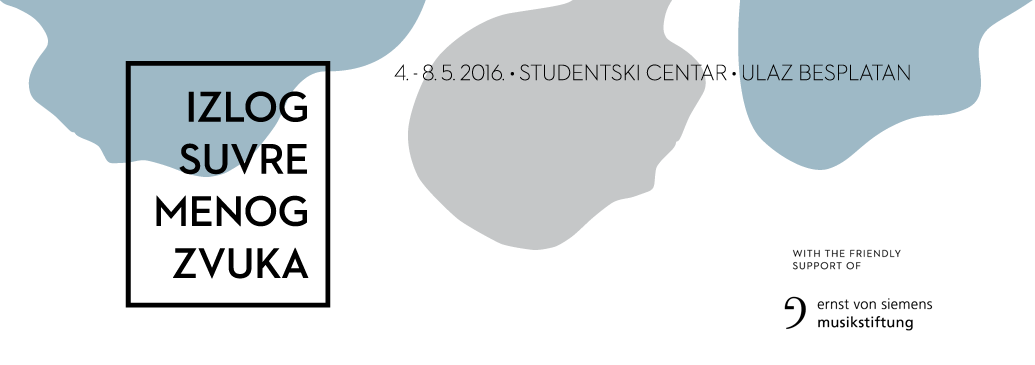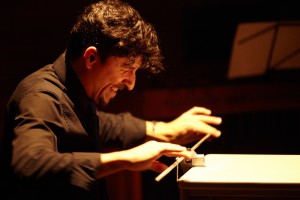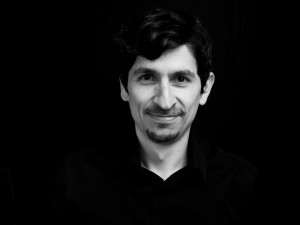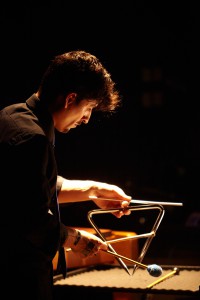
Diego Espinosa

FRIDAY, May 6
10pm – Diego Espinosa: Items, Machines and the Performing Body as Instruments (program: Applebaum, Espinosa, Lach, Morales Murguia, Schwitters, Veličković) @ Theatre &TD semicircular hall (60′)

Diego Espinosa ©Tokyo Wonder Site photo by Toshiya Tsuda
Diego Espinosa Cruz González is a multi-percussionist/sound artist dedicated to expand the boundaries of contemporary performance practice through sound exploration. His works and experiments with a wide range of visual artists, music technologists and theatrical/physical percussion repertoire has led him to focus a great deal of energy on projects wherein the visual component of a composition is as important or even equal partner to the music. Espinosa has performed in all five continents collaborating with contrasting artists such as Pierre Boulez, John Zorn, Steve Reich and John Luther Adams. He has received international awards such as Performance Grand Prize at the Tokyo Experimental Festival Vol. 8 (playing music by Hugo Morales Murguia) and 2nd Prize at the International Gaudeamus Interpreters Competition. Espinosa founded, among other groups, The Electronic Hammer computer-percussion trio and Ear Massage percussion quartet. He was a steady member of cutting edge Dutch ensembles Slagwerk Den Haag, Atlas Ensemble, Ziggurat, SOIL, and Amsterdam Percussion Group.
Espinosa holds a Doctorate in Musical Arts (DMus) from McGill University, Montreal and a Masters from the Royal Conservatory in The Hague. He is a member of Liminar ensemble and the theater company Todas las fiestas de Mañana acting, playing and composing. Currently he is the musical director and performer of UNDERLINE, a new music-theatre coproduction of Oper Berlin and Munich Biennale with music by Hugo Morales Murguia to be presented in July 2016. He has recorded CDs and DVDs for Mode Records, Tzadik, Cantalloupe, Col legno, EMF, ENCORA, Karnatic Lab, Artek, EtCetera, and Navona Records.

Diego Espinosa
I constantly explore the boundaries of my practice. This implies challenging who I am by changing how I do things. In essence I use the performing body to explore the limits between categories and stereotypes, for example choreography and music, improvisation and fixed composition, poetry and music, invented instruments and the human body. In this concert the only conventional instrument used is the human body, these are some of the thoughts that spin around this program:
Running the risk of being electrocuted on stage is not a joke… However, the schizophrenic idea of living in constant danger may be ironized by approaching self-security devices musically.
As a multi-percussionist I am interested in the invention and modification of objects and instruments for musical purposes. In this sense, conventional musical instruments may be approached in different ways in order to produce new music and, in the same way, invented or modified instruments might lead to innovative ways of music performance where the player’s body is divided in acoustic and electronic tasks split between mouth, fingers, hands and feet respectively. Guajex, sUn and Modes of Assisted Ventillation use this platform in different ways.
How may a piece, where no sound is physically produced, be considered both a live music performance and a dance performance? Applebaum’s Aphasia was written ironically for a singer. It critics both, any famous pop-singer doing playback for an audience, as well as, the academic cult of high-tech-sensor-based music. This musically written choreography is polemic. Diego Espinosa

Diego Espinosa ©Tokyo Wonder Site photo by Toshiya Tsuda
Programme:
Diego Espinosa: Electro-cute (2016)
for stun guns
Kurt Schwitters: Ursonate (1928-32)
for voice, 1st mov.
Hugo Morales Murguia: Modes of Assisted Ventilation (2014)
for intubated flute and white noise
Juan Sebastian Lach and Diego Espinosa: Guajex (2013)
for custom electronic instrument
Jasna Veličković and Diego Espinosa: sUn (2013)
for magnets and coils
Mark Applebaum: Aphasia-Dialogue (2010)
for a singer (custom choreography by Diego Espinosa)